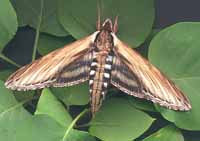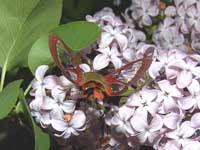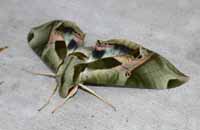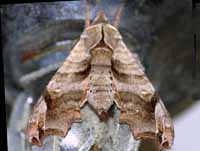Sphinginae subfamily
Sphingini tribe:
 |
Ceratomia amyntor WO, Elm Sphinx, Four-horned Sphinx:
Brown with dark brown and white markings including a white costal area near the wing base,
dark streaks along the veins, and a white spot in the cell. Elm (Ulmus), birch (Betula), basswood (Tilia), cherry (Prunus).
|
 |
Ceratomia undulosa USGS, Waved Sphinx:
Pale brownish gray (occasionally quite dark) with wavy black and white lines and black-outlined white cell spot. Hw: gray with diffuse darker bands.
|
 |
Lapara bombycoides WO, Northern Pine Sphinx:
The upperside of the forewing is gray with heavy black bands. The upperside of the hindwing is brownish gray with no markings. Larvae feed on pines.
|
 |
Lintneria eremitus USGS/DL/JS, Hermit Sphinx:
Larval hosts are various species of beebalm (Monarda), mints (Mentha), bugleweed (Lycopis),
and sage (Salvia). |
Sphinx eremitus adults nectaring at dusk on milkweed
July 17, 2007, courtesy of David Link.
Lintneria eremitus,
Gibraltar, larva and pupa: October 10, 2003, December 5, 2003; adult moth: June 23, 2004, courtesy of
Janice Stiefel.
 |
Manduca quinquemaculatus
USGS/JS, Five-spotted Hawkmoth:
Flies in tobacco fields, vegetable gardens
(potatoes, tomatoes), wherever host plants are found.
|
Manduca quinquemaculatus,
Bailey's Harbor, July 30, 1999, courtesy of
Janice Stiefel.

|
Sphinx canadensis USGS/JS,
Canadian Sphinx: Uncommon, not often reported anywhere.
Larval hosts are white ash (Fraxinus americana) and blueberry
(Vaccinium).
|
Sphinx canadensis,
Bailey's Harbor, July 16, 2001, courtesy of Janice Stiefel.
 |
Sphinx chersis WO/JS, Northern Ash Sphinx, Great Ash Sphinx:
Soft dark gray to blue-gray with series of black dashes, one of which reaches wing tip.
|
Sphinx chersis larva and adult moth,
Gibraltar, August 5, 2002, courtesy of Janice Stiefel.
 |
Sphinx drupiferarum JS, Wild Cherry Sphinx:
Probably flies in May/June and August. We have them on P.E.I., but I do not see them
nearly as frequently as I see the other Sphingidae. |
Sphinx drupiferarum,
Gibraltar, May 20, 2003, courtesy of Janice Stiefel.
 |
Sphinx kalmiae USGS/JS, Laurel Sphinx:
Predominantly brownish-yellow with fairly wide dark bar along inner margin. At rest wings
hug body, giving moth long slender look.
|
Sphinx kalmiae,
Bailey's Harbor, July 16, 2003, courtesy of Janice Stiefel.
 |
Sphinx luscitiosa WO/TB, Canadian Sphinx:
Clemen's Sphinx: Yellowish gray in males; pale gray with faint yellow tint in females. Dark
border on the outer margin widens as it approaches the inner margin.
|
Sphinx luscitiosa male, 6:05pm, July 3, 2012, courtesy of Tim Borski.
 |
Sphinx poecila
WO/JS, Poecila Sphinx:
If you have blueberries in the woods, then you probably have
Poecila Sphinx. They are probably widespread throughout Wisconsin,
but are very much under reported. |
Sphinx poecila,
Bailey's Harbor, June 13, 2003, courtesy of
Janice Stiefel.
Smerinthini Tribe:
 |
Amorpha juglandis USGS, Walnut Sphinx:
Highly variable; sometimes wings may be all one color or may have several colors,
ranging from pale to dark brown, may have white or pink tinge. Female is different.
|
 |
Paonias excaecata USGS, Blinded Sphinx:
Fw outer margin quite wavy. Dark cell spot and dark oblique line mid wing from costa almost to the
inner margin. Basic ground colour is pinkish brown. Flight would be June-July.
|
 |
Paonias myops
WO/JS, Small-eyed Sphinx: This species ranges across North America.
The hindwings have a small blue eyespot ringed with black on a yellow background.
|
Paonias myops Bailey's Harbor, August 6, 2004,
courtesy of
Janice Stiefel.
 |
Pachysphinx modesta USGS, Modest Sphinx, Poplar Sphinx:
This large poplar/willow feeder is reported in Door County.
They are a heavy bodied species.
|
 |
Smerinthus cerisyi USGS/JS, Cerisyi's Sphinx, One-eyed Sphinx.
Poplars, willows. Flight would be from late May-July as a single brood.
|
Smerinthus cerisyi,
Bailey's Harbor, June 6, 2001, courtesy of Janice Stiefel.
Smerinthus jamaicensis,
Bailey's Harbor, May 23, 2003, courtesy of
Janice Stiefel.
Macroglossinae subfamily
Dilophonotini Tribe:
See Hemaris comparison to help distinguish the next four species.
 |
Hemaris aethra
Note large orangey-brown forewing apical patch. In very similar H. diffinis patch is smaller.
On average H. aethra, compared to H. diffinis, tends to be slightly larger, with more orangey-yellow tone,
less tapering (top to bottom) of dark thorax/abdominal region; more red nr hw anal angle. possibly limited to northern Wisconsin.
|
 |
Hemaris diffinis WO, Snowberry Clearwing:
Flies along forest edges, meadows, gardens,
brushy fields. Day-flying adults nectar at lantana, dwarf bush honeysuckle,
snowberry, orange hawkweed, thistles, lilac, Canada violet, etc.
|
 |
Hemaris gracilis WO, Slender Clearwing, Graceful Clearwing:
This day flier is not commonly reported, but it might be present in
Door County. unlikely
|
 |
Hemaris thysbe WO/JS, Hummingbird Clearwing:
They are widely distributed in the east from P.E.I. to Florida.
|
Hemaris thysbe, July 2002 larva to May 2003 moth, courtesy of Janice Stiefel.
Philampelini Tribe:
 |
Eumorpha achemon WO, Achemon Sphinx:
This moth is not reported for Door, but it may be present.
Note the differences between this moth and the Pandorus Sphinx.
|
 |
Eumorpha labruscae JS, Gaudy Sphinx:
Although primarily a tropical species, it has been taken as far north as Saskatchewan as a stray.
Forewings are a vibrant grey-green. Rare fall stray to Wisconsin
|
Eumorpha labruscae,
Newport State Park, October 2, 2007, courtesy of
Janice Stiefel.
 |
Eumorpha pandorus WO, Pandorus Sphinx:
If you have Grape or Virginia Creeper nearby, then you probably have this species. I often get asked to identify larvae from areas where
they have not previously been reported. |
Macroglossini Tribe:
 |
This day flier is widely distributed. If you have Virginia Creeper,
you probably have the Nessus Sphinx. Two bright, distinct, narrow
yellow bands are often visible on the abdomen.
|
 |
They are common in New Jersey and common
here on Prince Edward Island.
You will often see this species listed as Darapsa pholus,
especially in older literature.
|
Darapsa choerilus,
Bailey's Harbor, July 2, 2003, courtesy of
Janice Stiefel.
 |
Darapsa myron
WO/JS, the Virginia Creeper Sphinx or the
Grapevine Sphinx
This moth is not recorded on the U.S.G.S. site for Door County, but
Janice Stiefel confirms its presence there via a found larva that
overwintered in pupal stage
and emerged the following spring.
It is widely reported in southern Michigan and in southern Ontario.
|
Darapsa myron,
Bailey's Harbor, May 18, 2003, courtesy of
Janice Stiefel.
 |
This species has not been recorded in Door.
It is seen in southern Ontario, however, and in central and
southern Wisconsin. |
 |
Hyles gallii
WO, the Bedstraw Hawk Moth
or Gallium Sphinx
This species is not reported in Door, but it has been recorded in
other eastern Wisconsin counties. I suspect it is present.
Some years I see them on P.E.I., some years, I do not.
|
 |
Hyles lineata
WO, the White-lined Sphinx
Adults usually fly at dusk, during the night, and at dawn, but they
also fly during the day over a wide variety of open habitats
including deserts, suburbs, and gardens. |
 |
This moth is very much under reported on USGS. It is a
rapid day flier so is probably not in too many collections.
Grape is a popular larval host.
|
Sphecodina abbottii,
Gibraltarr, July, 21, 2002, larva, subsequent moth
on April 25, 2003, courtesy of
Janice Stiefel.
|
|





